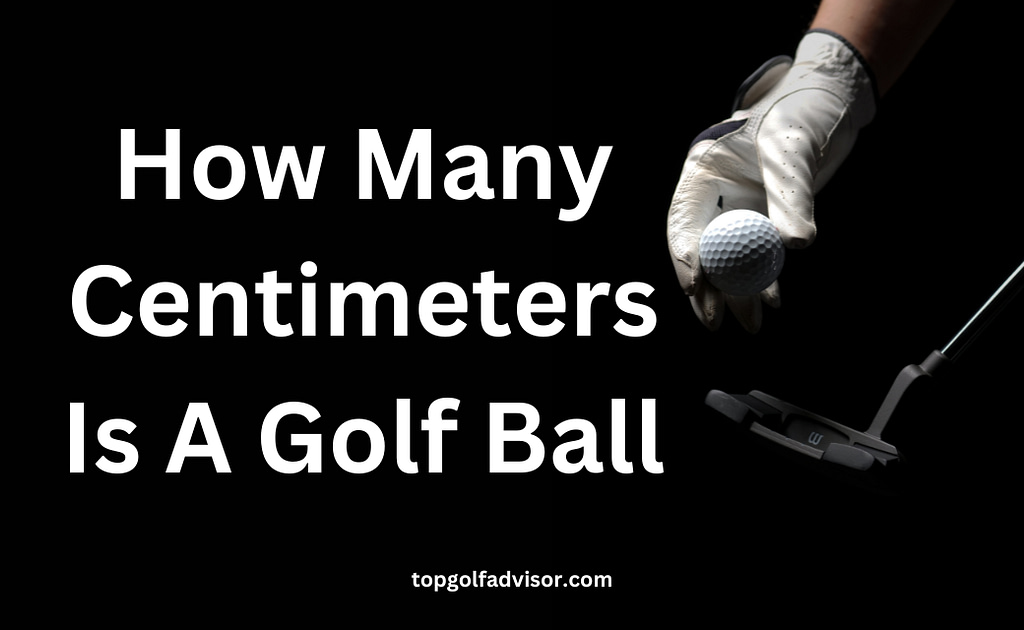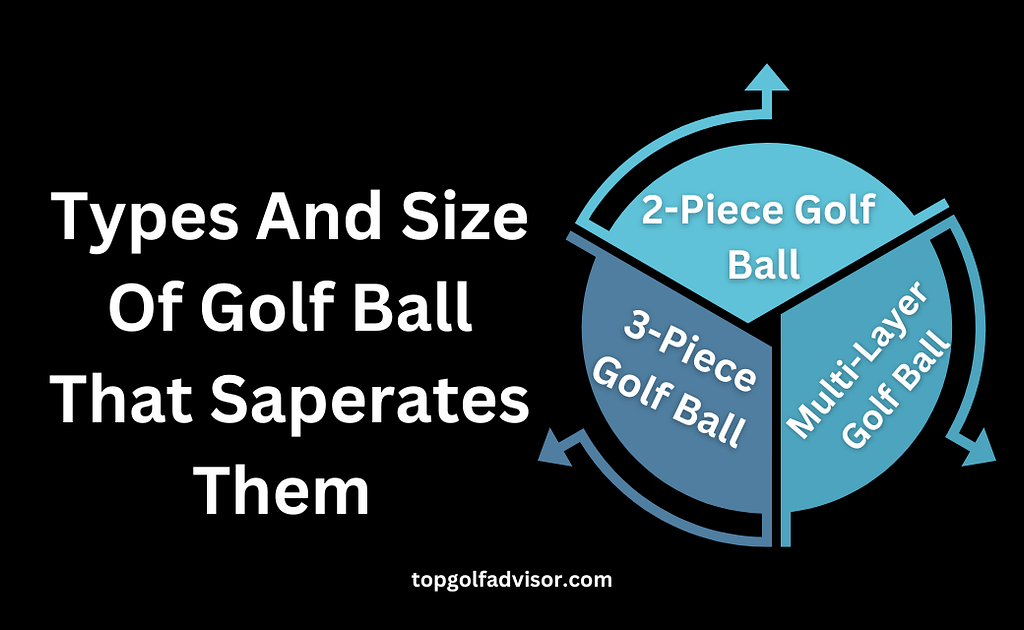There is little variation in the forms and sizes of golf balls. Unlike golf clubs, they always have a dull, white appearance and are spherical and tiny. It does not mean that all balls are made equally because there are differences in weight, covering, and, most significantly, size. So, the real question is, how many centimeters is a golf ball? The variances might seem like little on paper, but they greatly affect how you play the golf course.
This comprehensive guide that we put together will include all the information you require on golf ball size. We’ll also cover the diameters and everything else essential to understand the composition of the balls.

How Many Centimeters Is A Golf Ball Average Golf Ball Size?
A golf ball’s official diameter cannot be smaller than 1.68 inches. It is 42.68 mm or 4.268 cm in equivalent. The maximum weight allowed is 1.62 oz, or 45.93 grams.
The British R&A oversees golf in Scotland and England, and the USGA in America has approved these criteria.
Because that particular weight and diameter mix gives you the best distance and velocity at a somewhat high spin rate, it’s the most ubiquitous and optimum golf ball size.
Any ball of golf that exceeds this weight or diameter is prohibited by USGA golf ball standards and is deemed unlawful. Using these golf balls will disqualify a player from open tournament contests.
The USGA and R&A consider any golf ball larger or heavier than these typical diameters or weights illegal, and players who use these balls will be eliminated from tournament play.
There are a lot of golf balls available that manipulate the mechanism. Although they are prohibited in competition, the basic rule is that a ball with a smaller diameter will travel farther. Therefore, we need to remember how many centimeters is a golf ball for a chance at a cheat sheet.
Two ball sizes were standardized in 1952: the giant American ball had to weigh less than 1.62 ounces and have a diameter of at least 1.68 inches, while the smaller British ball had to have a diameter of at least 1.62 inches and a weight of fewer than 1.62 ounces.
The smaller golf ball flew straighter and farther than the giant ball; however, the difference was insignificant. Due to the advantage, American players who attended the British Opens switched to the little golf ball throughout those competitions.
Are All Golf Balls The Same Size?
There are two possible answers to that question.
You can use a variety of golf balls for casual or leisure play. Depending on what ball size best fits your playing style, it may vary smaller or larger. It is also common for some people to utilize different golf ball sizes because giant balls were more prevalent before the 1980s.
On the other hand, professional golfers ought to adhere to the rules set forth by the golf community specifically for professional competitions. To play by the rules in official competitions, you must utilize a ball of the appropriate size.
What Is The Difference Between American Golf Balls & British?
How many centimeters is a golf ball? According to USGA (United States Golf Association) regulations, the American ball must have a diameter of 1.680 inches and weigh no more than 1.620 ounces, or 45.93 grams. The R&A, the British Golf Association, permitted the standard usage of golf balls with a diameter of less than 1.68 inches up to the 1990s. Pro and amateur players called these shorter golf balls the “British ball.”
What Separates a Multi-Layer, 3-Piece, and 2-Piece Golf Ball? Does size become affected by this?
Manufacturers of golf balls have practically made the terms “two-piece,” “three-piece,” and “multi-layer” part of their marketing language. Consumers must understand these terms and how they might improve or detract from your game.
2-Piece Golf Ball:
A two-piece golf ball is constructed just as its name suggests. It consists of two parts: a tiny core surrounded by a shell. These golf balls have less spin, fly straighter, and are more durable. The two-piece ball is made for the higher handicap player or the novice who prefers distance to feel when playing golf.
Better players usually keep the two-piece ball on a rack because it doesn’t have the best grip on or around the greens. Economically speaking, the two-piece ball is the most affordable choice.
3-Piece Golf Ball:
The ball in three pieces is your middle-of-the-road choice. They will still provide plenty of distance but feel slightly nicer than the two-piece. They will spin more than the two-piece but less than the multi-layer ball.
The three-piece ball can be an excellent choice if you are a mid-handicapper seeking distance while also making sure the ball doesn’t feel like a rock as you put it. The performance you receive from the three-piece ball will make the slight price difference worthwhile, even if it is more expensive than the two-piece model.
Multi-Layer Golf Ball:
These are the lavish, pricy ones. They are the golf balls that cause individuals to lie on their stomachs, extending their arms and using a ball retriever to get the ball back. Should you misplace a couple of these, the cost will be nearly equal to the round’s.

Are These Balls More Expensive?
These urethane-covered golf balls usually consist of four or five pieces. Their design makes them feel far more comfortable around the holes and produces a lot of spin.
If you want to halt it on a green and spin it backward, it’s the ball you use. These spheres tend to cut more easily because their covers are softer than those of the two- or three-piece variants.
The size of the golf ball is unaffected by the type you are using. The USGA enforces tight criteria that all manufacturers must follow. Therefore, you don’t have to worry about how many centimeters is a golf ball with these products. Also, check our blog on How Are Golf Balls Made.
Standard Golf Ball Size According To Today’s Rules:
How Many Centimeters Is A Golf Ball & Diameter of it?
The diameter of a golf ball required to be USGA-legal must be 1.68 inches or 42.67 mm. It can only weigh up to 1.62 ounces, or 45.93 grams. The USGA in America and the British R&A, which oversees golf in Great Britain, Northern Ireland, and other countries, have established these guidelines.
The USGA and R&A consider any golf ball heavier or bigger than these typical diameters or weights illegal, and players who use these balls will be eliminated from tournament play. How many centimeters is a golf ball? It is equally crucial to the diameter of a golf ball.
There are a lot of golf balls available that manipulate the mechanism. Although they are prohibited in competition, the basic rule is that a ball with a smaller diameter will travel farther.
Two ball sizes were standardized in 1952: the larger American ball had to weigh less than 1.62 ounces and have a diameter of at least 1.68 inches, while the smaller British ball had to have a diameter of at least 1.62 inches and a weight of less than 1.62 ounces.
The smaller golf ball flew straighter and farther than the larger ball; however, the difference could have been better. Due to the advantage, American players who attended the British Open switched to the little golf ball during those matches.
Each side of the ocean attempted to agree in September 1970 to use a golf ball with a 1.66-inch diameter.
How Many Dimples Do Golf Balls Have?
There is no industry standard for a golf ball’s surface dimple count. Equipment manufacturers can use technology to make as many creases as they like, but the golf ball’s small size limits the dimples to no more than 500. There are 392 dimples on the well-known Titleist Pro V1 golf ball. Also, because of no standard count, you don’t have to worry about dimples as much as how many centimeters is a golf ball.
What Is The Size Of A Golf Hole?
The 4.25-inch width for a golfing hole was approved in 1891 by the British R&A rules organization.
The size of this hole was greater before the installation of these laws, sometimes reaching a depth of six inches. Moreover, this hole size is intended to challenge the competition while allowing for distant hole-outs.
It will be difficult to refute anyone claiming the gap is too small. Golf is a game where people like us are meant to take on challenges and conquer them, hoping to hit flawless shots that end up in the hole. With the 4.25-inch cup, golf has been running strong for a long time and continues to play now.
Neither of these two governing organizations is discussing modifying the 4.25-inch rule for professional golf.
Final Words:
Fortunately, of all golfers’ concerns, how many centimeters is a golf ball not among them? Getting a golf ball that doesn’t comply with a big warehouse store or neighborhood golf shop is impossible.
Furthermore, a new golf ball will have undergone extensive testing to ensure it is suitable for play within the rules of golf, even if it is introduced with the promise that it is longer and softer than every other ball on the market.
Moreover, this blog helped clear any doubts you have, including differences, history, and rules regarding the game. If yes, check out more relatable and informative blogs on our site.
FAQs
What Is The Volume Of A Golf Ball?
The USGA and R&A permit a golf ball with a circumference of 1.68 inches, hence when calculating a ball’s volume, the result is 2.48 cubic inches, or 40.68 cm3. However, the quantity and depth of the dimples might also lessen that volume.
What is a Golf Ball Size In Mm?
According to United States Golf Association (USGA) rules, a typical golf ball’s diameter is roughly 42.7 millimeters (or 4.27 centimeters).
Do Golf Balls Make A Big Difference in Your Game?
Golf balls only really matter to the more seasoned golfers. They require a ball that can spin and travel large distances at this level. Moreover, individuals new to using these features or with significant disabilities are still developing the necessary skills. The use of more expensive balls will not be very beneficial to them.
